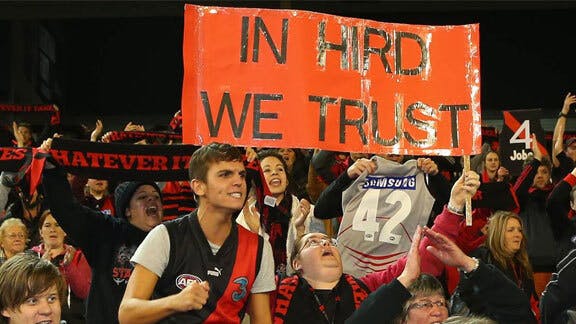‘Through injuries and beyond pain’ – how exceptional are the Bombers?

We knew almost from the beginning that what transpired at Windy Hill was reckless, potentially dangerous, toxic on many levels and inexcusable.
The Essendon Football Club’s own internal investigation, released three months after the supplements scandal broke in February 2013, noted “a disturbing picture of a pharmacologically experimental environment never adequately controlled or challenged or documented”.
We now know much more than even this damning disclosure – which its author, Ziggy Switkowski, called “constrained”. The Court of Arbitration for Sport has found 34 past and present players guilty of taking the banned peptide thymosin beta-4. Careers and reputations are in tatters. And the consequences of the 2012 experiment are still to be fully realised.
Debate has intensified over who should take responsibility for what happened in 2012. The broader question is: how exceptional were the dynamics at work at this club?
An anecdote to help situate that question: in high school I was an enthusiastic track sprinter, although not particularly fast. Training sometimes would entail a series of flatout 300s with short breaks between each effort. After a decent set, the dizziness came. Sometimes I would stumble and collapse in a heap, with a feeling akin to being badly wasted on vodka. Sometimes I would stay that way until I heaved and threw up whatever liquid was in my stomach.
Friends and acquaintances, amateurs in athletics or other sports, were not much different, except that many trained harder than me. Most of them knew that they wouldn’t make a career out of it either, though some did. I think the majority of us took supplements of one type or another, usually protein powders.
When you think biologically about what we were doing, it was hardly healthy:
“What did you do today?”
“I deliberately starved my lungs of oxygen until I thought my chest was about to implode, pumped my muscles full of lactic acid until I could do little but grimace, and drained my body of sugars at a rate that resulted in it temporarily shutting down or something. Then I threw up. Now I’m drinking this shake to make sure I have the strength to do it again in two days’ time.”
But such punishment was necessary if you were to be competitive. And even if you were only semi-serious, you definitely wanted at least to look competitive.
The point of the story is that sporting culture, even at an amateur level, reflexively mimics certain characteristics of the capitalist society we inhabit: winner takes all; bodies treated as machines and worked to their limits; anything short of exhaustion considered a bludging indulgence.
I couldn’t help but think back to this run of the mill teenage experience when I read James Hird, now disgraced for his role in this affair, in the Herald Sun after the CAS verdict.
“[P]layers of both my era and past eras pushed ourselves beyond what the body was capable of, often through injuries and usually beyond pain, all the while ignoring the long term consequences”, he wrote.
“At this time, the use of painkillers, anti-inflammatory and sleeping tablets were the norm but would lead to side-effects such as long term arthritis, long term neural pain, eroded stomach linings, addictions and sleeping disorders to name a few.”
It’s not surprising that the average career length in the AFL is six years. The intensity of the training and the matches is extreme. Professional football is a total mobilisation of resources, not simply mimicking broader economic logics as high school athletes do, but thoroughly expressing them. The AFL is a multi-billion dollar industry, hungry for ever greater profits.
An army of administrators, coaches, therapists and scientists manage the human bodies that form the core commodities of the business – the players, whose heavily monitored, medicated and engineered performances will determine a club’s revenue.
So is Essendon that exceptional? Only because the club got sloppy and crossed the experimental boundaries. Pushing players “through injuries and beyond pain” and dosing them up – “giving them a jab” as the commentators routinely note during games in which injuries occur – with whatever will keep them on the field is the norm.
Because the AFL is not just a game, but a business, the limits of player endurance, strength, pain tolerance and recovery will continue to be tested. For the time being, less caution will be thrown to the wind. But this won’t be the last time young men’s bodies and careers are sacrificed.